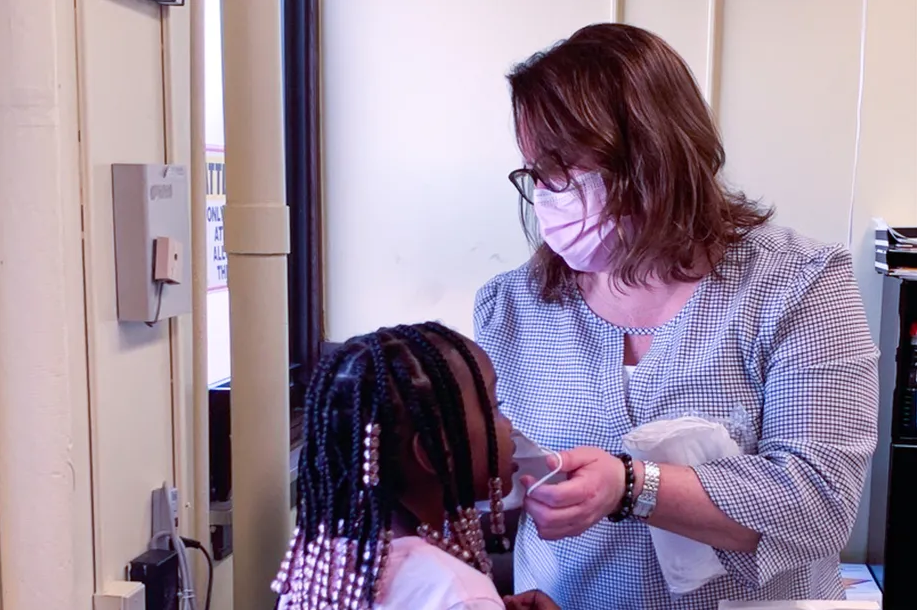
It was just after 11 a.m., and Jennifer Gardner literally had her hands full. She held a cell phone to her ear with her left hand, while reaching for a corded office phone with her right.
“Good morning, Cooke Elementary School, can I help you?”
On the office line was a parent who needed information about registering her child. As Gardner spoke, she pressed the button on the security camera on the desk to let someone in the front door.
A third grade boy who had been sent to the office after a toileting mishap trailed her everywhere. Now, he eyed the paper and pencils on the desk. “Can I draw a picture?” he asked.
Gardner opened a drawer full of colored markers for him just as a little girl showed up who needed a new mask.
“Masks, we have lots of masks,” she said, as she helped her put it on. By then, the person at the door was in the office, dropping off her child after a doctor’s appointment. Gardner saw to it that the student got to her classroom.
As the director of finance and subsidies in the Philadelphia school district’s information technology office, Gardner usually would be attending meetings and processing paperwork for federal technology and infrastructure grants in the district’s headquarters at 440 N. Broad Street.
But on Wednesday she worked as a secretary at Cooke, a 400-student K-8 school in North Philadelphia’s Logan neighborhood. She is one of 250 central office staffers who since Nov. 29 have deployed to schools to help cope with vacancies and absences – a critical problem this year in Philadelphia as well as in districts across the state and the country.
Christopher Davies, the district executive who is managing the program, said that based on vacancy and staff absenteeism data, officials targeted 19 schools for help, including Cooke. Central office departments were asked to volunteer to “sponsor” a school during the month between Thanksgiving and winter break.
The district’s online jobs board lists 535 school staff vacancies, not counting teachers. There are nine secretary vacancies, including Cooke, and dozens among climate staff, food service workers, and special education assistants, and other support positions.
The central office staffers fill in wherever they are needed. Chief Financial Officer Uri Monson, for instance, has done lunch duty at a South Philadelphia elementary school. “I’ve become an expert at opening ketchup packets,” he deadpanned at the end of an interview earlier this week about the district’s budget.
District Information Officer Christina Clark has done lunch duty at Blaine Elementary, which is being sponsored by the communications office. “All of us signed up for at least one day,” she said. “Some of us did two days.”
Davies said most of the 19 schools need help with operations, but seven also needed help with instruction. Central officer staffers with teaching certification have gone to those schools and run classrooms, he said.
“Every division within the district is represented in terms of the support provided to schools,” he said. “Some offices are sponsoring multiple schools. And we’ve heard from principals how helpful this has been and from central office members about how the experience has been eye-opening and invigorating.”
Philadelphia, he said, “is not unique in terms of having challenging attendance and staffing shortages,” he said. Many teachers and students are dealing with trauma and loss from the pandemic.
As a result, “folks are being asked to wear multiple hats, and that contributes to absences,” he said.
Cooke Principal Christie Parfitt said having Gardner and the other staffers to help in the main office has been a godsend. In many ways the secretary is the nerve center of the school, keeping things running smoothly.
Cooke’s secretary resigned in November. Since then the school’s climate manager, Linda Knox, has taken over the organizing duties in the main office, supplemented by the temporary help from Gardner and the other IT staffers who are filling in.
“It’s an all-hands-on-deck situation,” said Parfitt, a former science teacher in her second year as Cooke’s principal. In September and October, the school also had a lot of teacher absenteeism, but that has settled down and camaraderie among the staff has increased, she said.
People in the school realize “we have to support the students and support each other,” she said.
A veteran with more than two decades in the district, Gardner spent her early years going out to schools to service and repair computers and other technology. “I started out in the field,” she said. “It’s good to be back out here.”
The last time she filled in, on Dec. 6, she arrived at 8:30 a.m. and didn’t leave until 4:30 p.m. That day, a kid got sick on the floor and she had to clean it up – “typical school things that you forget when you are sitting in 440,” she said, referring to the main administration building.
That day, a family came in to register because the children were changing guardians. It was a complicated situation, so Gardner, a mother of two, took charge of the 2-year-old. “He missed his nap,” she said. “So I picked him up, and he fell asleep on my shoulder.”
Recalling the moment, Gardner said “You forget how schools are a center of safety and security” where students know “people are looking out for them and paying attention to them.” She said she hopes they won’t close again due to a COVID surge.
While she has no plans for a career change after her time at the school, she adds: “If I could do my regular job from here, I would.”
This article was originally posted on Central office staff helping in Philadelphia schools struggling with vacancies and absences